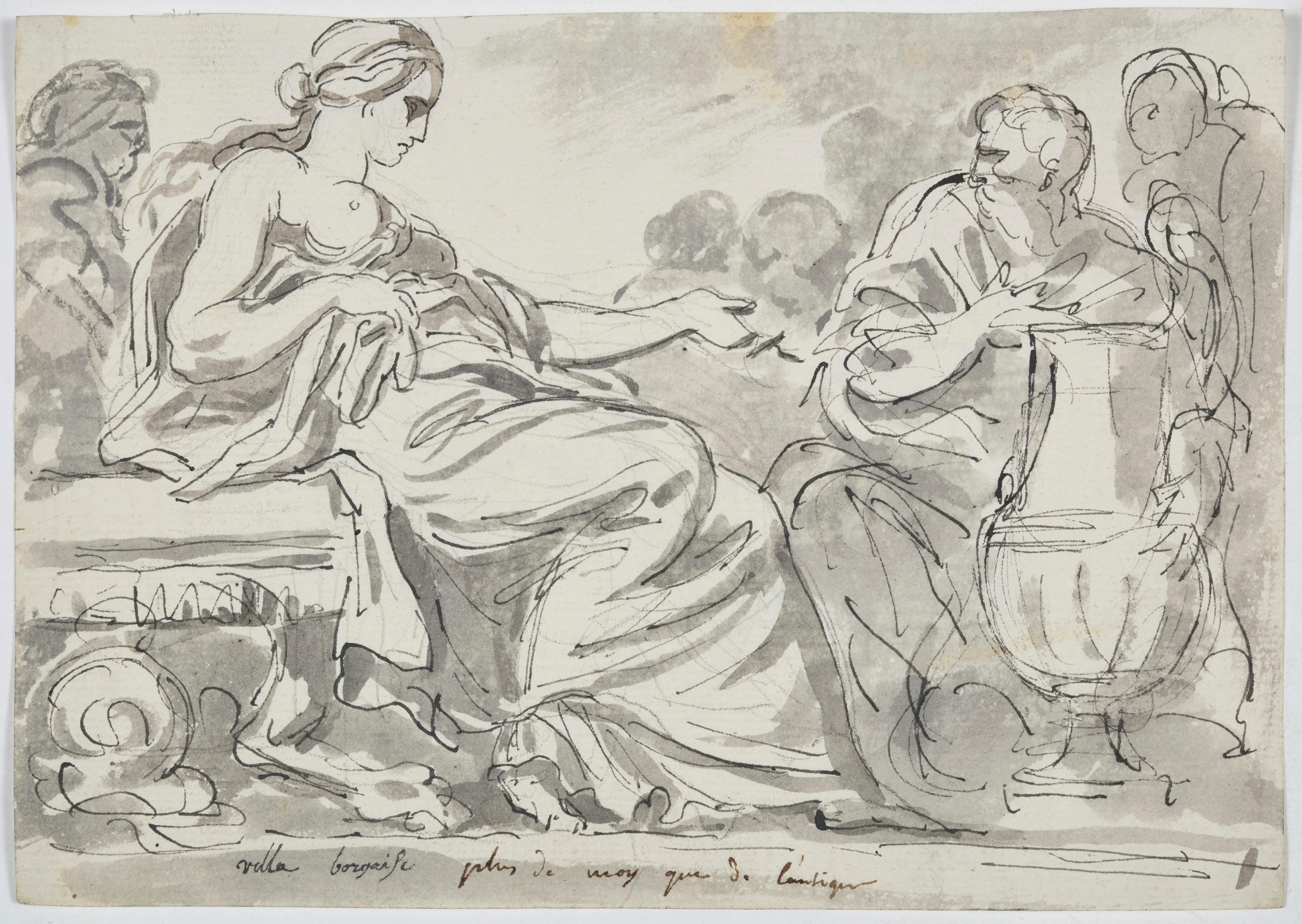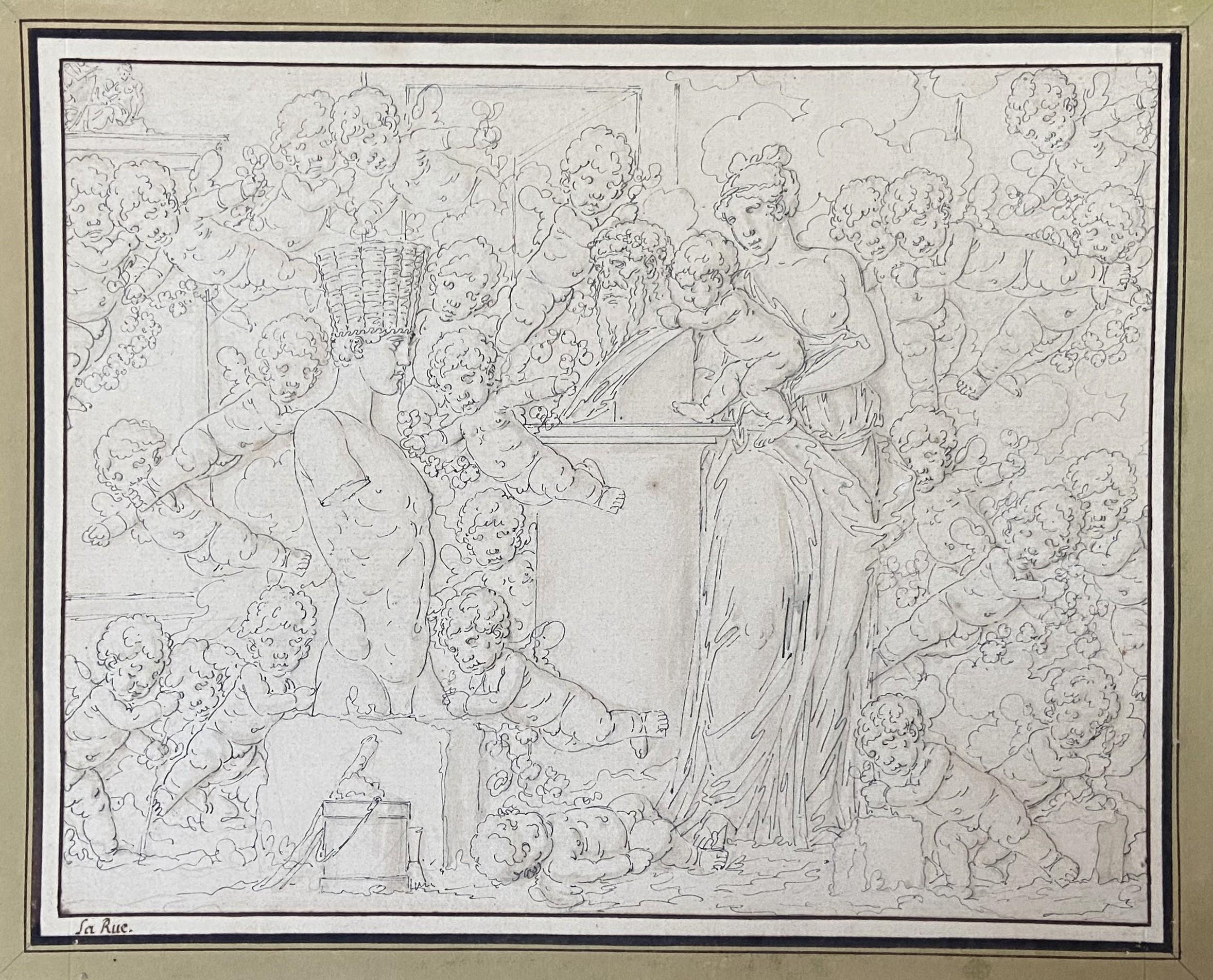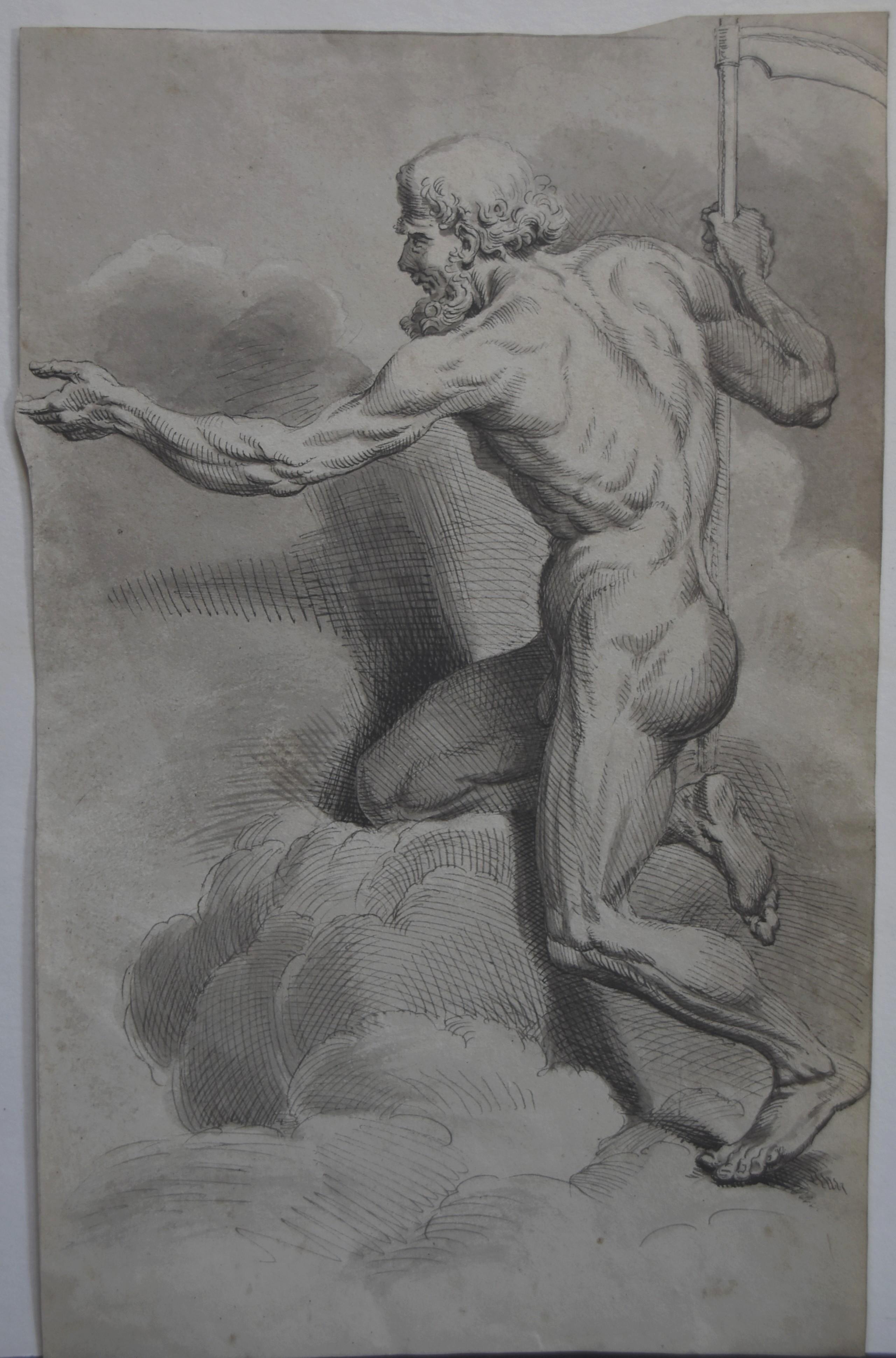Items Similar to The Martyrdom of the Santi Quattro Coronati
Want more images or videos?
Request additional images or videos from the seller
1 of 5
Anton Domenico GabbianiThe Martyrdom of the Santi Quattro Coronati
About the Item
Provenance:
Private Collection, UK
After initial training under Justus Suttermans and Vincenzo Dandini, in 1673 Anton Domenico Gabbiani embarked for Rome where he spent three years studying at the Medici-sponsored Accademia per artisti fiorentini. There he came under the influence of Ciro Ferri, then Director of the Accademia alongside Ercole Ferrata. The impulsive handling of this powerful composition was clearly inspired by Ferri’s drawings, as well as those of his master, Pietro da Cortona. Gabbiani returned to Florence in 1680 to begin an independent career. The present drawing probably dates from around this time and is preparatory for a now lost painting by Gabbiani that once hung in the tenth-century Oratory of Santa Maria Primerana in Fiesole.
The subject of the drawing and Gabbiani’s ex-voto painting is the Martyrdom of the Santi Quattro Coronati. Representations of the martyrdom of these four saints, condemned to death in the third century AD by the Emperor Diocletian, are comparatively rare. Their images were venerated in Italy, albeit sporadically, since around 1300, but the late sixteenth century witnessed a long-lasting surge in depictions of their martyrdom, commissioned by the Guilds of stonemasons, carvers, and sculptors. The quarries around Fiesole had been mined since the Etruscan era by generations of highly trained local artisans. As their patrons and protectors, the Santi Quattro Coronati were of special significance to the city, hence the decision to commission Gabbiani’s painting for the Oratory. The Oratory itself was central to civic life and was a place of special devotion for sculptors. It is replete with works in marble, polychrome terracotta, and marble ex-votos, notably the portrait relief of the sculptor Francesco da Sangallo thanking the Virgin for her intercession.
Gabbiani’s composition in the present drawing shows a mass of writhing bodies as the martyrs—two tied back-to-back to the column and two on the ground—are mercilessly flailed for refusing to sculpt a pagan image. At the upper left, Diocletian presides over the execution. Gabbiani worked freely and rapidly, with great boldness and spontaneity. His handling was heavily influenced by Ferri and Cortona, as is clear in comparison with the latter’s Martyrdom of Saint Erasmus in the Uffizi (Fig. 1). Our drawing is similar in figure types, technique, and energy, yet manifestly Gabbiani’s in style. Whether presentation drawings, modelli, or compositional designs, Gabbiani’s drawings share three distinct features: wild chalk underdrawing (as at the right of the present sheet), robust, stocky figure types, and distinctively heavy pen lines in emulation of Ferri and Cortona. His style is at its freest and most animated when, as in the present sheet, he is in his inventive mode. A comparable example is found in his Rape of the Sabines (Fig. 2). Violent movement is conveyed by rapid and spontaneous tangled lines emerging from the web of swirling chalk—the more intense the scene, the denser and more animated his penwork.
Our drawing was at some point cut in half, as is evident from the framing lines surrounding all but the top of the sheet, as well as the shafts of light and cloud formations that finish abruptly at the topmost edge. Crucially, however, what survives is consistent with the information provided by Giglioli in his 1933 census of art and antiquities in Fiesole—that Gabbiani’s painting of the Martyrdom of the Santi Quattro Coronati was vertical in format. He also recorded that a pair of angels seated on clouds were shown in the upper part of the composition. The discarded section of the original sheet would doubtless have included the cloud-borne angels that appeared above the martyrdom scene.
The sheer number of early references to Gabbiani’s lost painting testify to its critical acclaim. It originally hung in the Oratory at ground level beneath the organ, making it accessible to worshippers. It was first documented in 1776 by Angelo Maria Bandini, followed by Domenico Moreni in 1792 for whom Gabbiani was “valente,” a powerful artist. Filippo Traballesi’s tract of 1802 confirms that it was relocated above the niche displaying Andrea da Fiesole’s sculpted Pietà, adjacent to the High Altar. There it remained into the nineteenth century, when it was praised in the early guidebooks of Francesco Fontani and Giuseppe del Rosso. Gabbiani’s ex-voto disappeared sometime after 1933, the year in which it was described by Giglioli. It was the property of the Opera of Santa Maria Primerana, the body responsible for its fabric, which commissioned the ex-voto. Sadly, by the 1930s it was in a terrible (“cattivo”) state, its surface badly cracked and its pigments discolored.
Fiesole’s quarries were a valuable source of Pietra serena of the finest quality, used to decorate major Florentine monuments from Brunelleschi’s Pazzi Chapel to Michelangelo’s Medici Chapel, but the process of extraction was extremely dangerous. Given the dimensions of Gabbiani’s painting and the context in which it was displayed, it evidently functioned as a votive offering in memory of the generations of local stonemasons and quarrymen who had died, and for those who had recovered from injuries sustained as a result of their profession. The present drawing is all that remains of what was obviously an impressive and—especially for Fiesole—a highly meaningful and valued work, before which generations of stoneworkers would have expressed their devotion, given thanks, or prayed for protection. Moreover, it stands as a valuable record of what was among the most dramatic renderings of the subject for this period.
We are grateful to Dr. Simonetta Prosperi Valenti Rodinò for confirming Gabbiani’s authorship of this drawing.
- Creator:Anton Domenico Gabbiani (1652 - 1726, Italian)
- Dimensions:Height: 10.375 in (26.36 cm)Width: 10.375 in (26.36 cm)
- Medium:
- Movement & Style:
- Period:
- Condition:
- Gallery Location:New York, NY
- Reference Number:1stDibs: LU1029077992

About the Seller
5.0
Recognized Seller
These prestigious sellers are industry leaders and represent the highest echelon for item quality and design.
Established in 1997
1stDibs seller since 2012
17 sales on 1stDibs
Typical response time: 11 hours
- ShippingRetrieving quote...Ships From: New York, NY
- Return PolicyThis item cannot be returned.
More From This SellerView All
- Study after Michelangelo’s “The Last Judgment”By Michelangelo BuonarrotiLocated in New York, NYItalian School, 16th Century Provenance: Private Collection, New York This intriguing drawing is a study by an anonymous 16th-century Italian artist after a vignette in Michelangelo’s fresco of The Last Judgement in the Sistine Chapel. The altar wall of the Sistine Chapel was already richly decorated when Pope Clement VII commissioned Michelangelo to paint his Last Judgment...Category
16th Century Old Masters Figurative Drawings and Watercolors
MaterialsPaper, Gouache
- A Musical PartyBy German SchoolLocated in New York, NYProvenance: Dr. George Hamilton, Massachusetts; and by descent. Private Collection, Ohio, until 2021. Exhibited: (Possibly) Clark Art Institute, Massachusetts (according to a handwritten inscription on the reverse). This drawing by an anonymous, 16th-century German hand presents a delightful scene of nymphs—mostly nude but some draped with cloth—making music in an outdoor setting. The composition is executed within a roundel and centers on the harpsichord played by the figure seen from behind. She is accompanied by a host of other instruments, including horns, a harp, and a lira da gamba played by figures gathered nearby, several of which are positioned along the curved edges of the visual field. Two satyrs observe the merrymaking—one leans on the harpsichord while the other holds aloft a cup, presumably of wine, adding a bacchic element to the revelry. The drawing was previously owned by Dr. George Hamilton, scholar of modern art and Director of the Sterling and Francine Clark Art Institute in Williamstown (1966–1977). Hamilton played...Category
16th Century Old Masters Landscape Drawings and Watercolors
MaterialsPaper, Ink, Pen
- The Flight into EgyptLocated in New York, NYInscribed: 3. una Madonna che va in Egitto, verso, and Madonna che va in Egitto, recto Provenance: Private Collection, UK, since 1999 This expressive and boldly executed drawing is the work of Luca...Category
16th Century Old Masters Figurative Drawings and Watercolors
MaterialsChalk, Ink, Pen, Paper
- A Mother and Child, Two Children, and a DogBy Stefano Della BellaLocated in New York, NYProvenance: Elsie de Woolfe, Lady Mendl, Paris; by whom given in 1950 to: Arlene Dahl, New York (until 2021) Inventive, whimsical, and fantastic; delightful, imaginative, and maca...Category
17th Century Old Masters Interior Drawings and Watercolors
MaterialsPaper, Ink, Pen
- The Assumption of the VirginLocated in New York, NYProvenance: Unidentified collector’s mark “D.G.R,” lower right (Lugt 757b) Wilhelm Suida (1877–1959), New York; by descent to: Robert L. and Bertina Suida Manning, New York, until 1996 Private Collection, USA This impressive drawing of the Assumption of the Virgin is the work of the Genoese artist Giovanni Battista Paggi. The son of a nobleman, Paggi received a humanist education and was a self-taught artist. According to Paggi’s first biographer, Raffaele Soprani, it was only after encountering Luca...Category
16th Century Old Masters Figurative Drawings and Watercolors
MaterialsPaper, Ink, Pen
- Study of a Nude ManBy Francesco MaffeiLocated in New York, NYProvenance: John Barnard, London (Lugt 1419) or possibly Saint John Dent, London and Milton (Lugt 1438) Unidentified collector’s mark “W,” lower left of the mount (Lugt 2591a) Private Collection, USA. This expressive and boldly executed drawing is a work by Francesco Maffei...Category
17th Century Baroque Drawings and Watercolor Paintings
MaterialsPaper, Ink, Pen
You May Also Like
- Three drawings by François Boucher in a mounting by Jean-Baptiste GlomyBy François BoucherLocated in PARIS, FRWe would like to thank Juliette Parmentier-Courreau of the Custodia Foundation for her welcome and support during the consultation of Glomy’s Journal des Ouvrages. This spectacularly large "feuille de desseins ajustés" commissioned by François Boucher from Jean-Baptiste Glomy is emblematic of the painter's art and mastery of rocaille. It is also fully representative of the taste of this period in the field of decorative arts. The largest of these three drawings, placed at the bottom of the composition, is particularly interesting: dating from around 1756, it constitutes a modello (apparently unpublished) for the frontispiece of the "Catalogue des tableaux de Monsieur de Julienne"), preserved in the Morgan Library in New York. 1. François Boucher, the master of French rocaille The extraordinary career of Francois Boucher was unmatched by his contemporaries in versatility, consistency and output. For many, particularly the writers and collectors who led the revival of interest in the French rococo during the last century, his sensuous beauties and plump cupids represent the French eighteenth century at its most typical. His facility with the brush, even when betraying the occasional superficiality of his art, enabled him to master every aspect of painting – history and mythology, portraiture, landscape, ordinary life and, as part of larger compositions, even still life. He had been trained as an engraver, and the skills of a draftsman, which he imbued in the studio of Jean-Francois Cars (1661 – 1738), stood him in good stead throughout his career; his delightful drawings are one of the most sought-after aspects of his oeuvre. As a student of Francois Lemoyne (1688 - 1737), he mastered the art of composition. The four years he spent in Italy, from 1727-1731, educated him in the works of the masters, classics and history, that his modest upbringing had denied him. On his return to Paris in 1734, he gained full membership of the Royal Academy of Painting and Sculpture with his splendid Rinaldo and Armida (Paris, Musée du Louvre). Although, throughout his career, he occasionally painted subjects taken from the Bible, and would always have considered himself first as a history painter, his own repertoire of heroines, seductresses, flirtatious peasant girls and erotic beauties was better suited to a lighter, more decorative subject matter. His mastery of technique and composition enabled him to move from large scale tapestry...Category
1750s Old Masters Figurative Drawings and Watercolors
MaterialsChalk, Ink
- Study of a Fate at mid-body, a red chalk attributed to Giovanni da San GiovanniLocated in PARIS, FRThis spectacular red chalk drawing depicts an elderly woman, her eyes bulging, her hand stretched out towards the sky. This disturbing character, who seems close to dementia, and the elongation of her arm with its Mannerist overtones, plunge us into the Florentine artistic milieu of the first half of the 17th century. The proximity of this drawing to some characters in the fresco in the Pitti Palace representing The Muses, Poets and Philosophers chased from Parnassus, the last masterpiece of Giovanni da San Giovanni, leads us to propose an attribution to this artist and a dating of around 1635-1636. 1. Giovanni da San Giovanni, the painter of contradiction We take here the title of the monography dedicated to the artist by Anna Banti in 1977, which remains the reference book for this artist. The son of a notary, Giovanni Mannozzi, known as Giovanni da San Giovanni, abandoned his studies to go to Florence at the age of sixteen, where he entered the studio of Matteo Rosselli (1578 - 1650) around 1609 and enrolled in the Academy of Drawing Arts in 1612. Around 1615 he produced his first known works, mainly frescoes for the city's tabernacles. He became famous in Florence for his originality, combining an obsessive application to the study of drawing and the reading of poetry and history with a disheveled appearance. Between 1619 and 1620 he decorated the facade of the Antella Palace in Piazza Santa Croce, a decoration that still partly survives today. The death of Cosimo II in 1621 put an end to the Florentine building activity and Giovanni da San Giovanni left for Rome to find other sponsors with the painter Francesco Furini...Category
17th Century Old Masters Nude Drawings and Watercolors
MaterialsChalk
- Study in the Antique Style, a neoclassical drawing by Augustin PajouLocated in PARIS, FRIn this lively and fresh drawing, probably taken from one of the artist's notebooks, Pajou presents us with a composition freely inspired by antiquity, as a souvenir of a visit to th...Category
1750s Old Masters Figurative Drawings and Watercolors
MaterialsInk
- Louis-Félix de La Rue (1730-1777) A Mythological scene, drawingBy Louis-Félix DelarueLocated in Paris, FRLouis-Félix de La Rue (1730-1777) A Mythological scene Pen and black ink on paper Bears an old inscription with the name of the artist on the lower left bo...Category
1770s Old Masters Figurative Drawings and Watercolors
MaterialsInk
- French Neo classical school, Allegory of Time, original drawingLocated in Paris, FRNeo classical school, France, end of the 18th Century Allegory of Time, Pen and black ink on paper, gray ink wash 30.5 x 19 cm irregularly shaped In g...Category
1790s Old Masters Nude Drawings and Watercolors
MaterialsIndia Ink
- Louis-Félix de La Rue (1730-1777) A Mythological scene, drawingBy Louis-Félix DelarueLocated in Paris, FRLouis-Félix de La Rue (1730-1777) A biblical or mythological episode Signed and dated lower right (under the mount, see photos of the drawing out of frame) ...Category
1770s Old Masters Figurative Drawings and Watercolors
MaterialsInk
Recently Viewed
View AllMore Ways To Browse
Antique Pen Stand
Pair Of Italian Angels
Pen And Ink Stand
Vertical Portrait Browns
Antique Organ
Antique Organs
Antique Organ Organs
Organ Antique
Polychrome Angel
Florentine Stand
Antique Votives
Antique Votive
Virgin With Angels
Emperors Seat
Florentine Portrait
Angel Painting 17th Century
17th Century Terracotta
Martyr Painting





